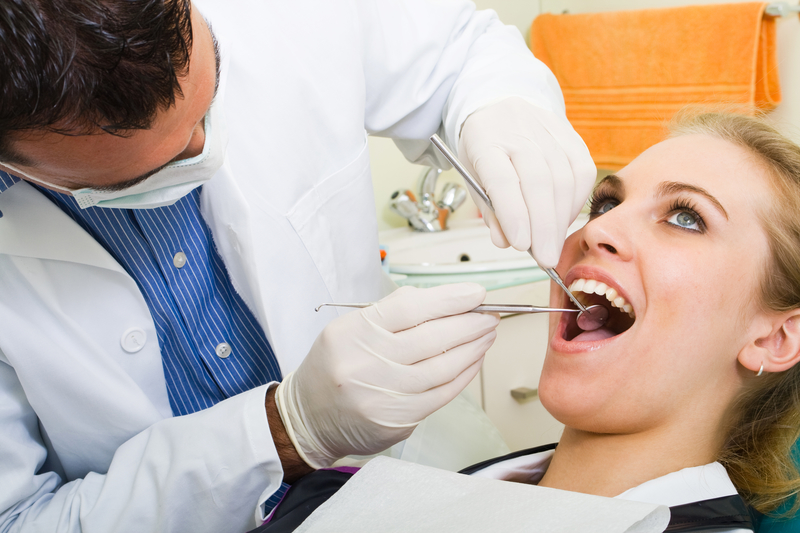Did you know that more than half the population don’t attend the dentist regularly? A lot of people avoid the dentist at all costs and some just go when they are desperate!
Your check-up appointment with the dentist is far more important and beneficial than people may think. Not only does it give your dentist a chance to check for cavities it can also help the dentist detect any abnormal or suspicious changes in your mouth. The dentist will carry an oral cancer inspection at every check-up appointment which in effect could save your life.
So what happens at a dental examination?
During a dental exam, the dentist will check for cavities and gum disease. The dentist or hygienist will also evaluate your risk of developing other oral health problems, as well as check your face, neck and mouth for abnormalities.
Are you one of the many nervous patients?
There are several reasons why people are phobic about visiting the dentist. It may be
something as simple as the clinical smell of a dental practice that puts people off or a previous bad experience that has scarred an individual for life. Below are a few reasons why you may be phobic about visiting the dentist. Rest assured that you are not alone: there are many millions of people that suffer from dental phobia.
Previous negative experience – you may have had a bad experience in the past that has put you off going to the dentist. This may be due to a painful procedure, a phobia of needles, or even a personality conflict with a dentist or dental staff.
Embarrassed about your oral health and the condition of your teeth and gums – you may have neglected your oral health and your teeth over the years and are embarrassed about visiting your dentist for fear of what they might think or say to you. Many people fear that their dentist will ridicule or belittle them.
You may have a fear of dental instruments being placed in your mouth. This may trigger a gag reflex or cause an anxious feeling where you find it difficult to breathe.
Unsympathetic dentists – you may have had an experience with a dentist who was not sympathetic to your needs and concerns, and this has put you off going back to see a dentist.
You may have a fear due to the stereotype of dentists on the TV, in the press or amongst friends and family. If you haven’t been to a dentist before, it may simply be a fear of the unknown.
Diagnosing TMJ/ Jaw Problems
The TMJ mainly works to coordinate movements of the jaw, like chewing and biting. Any disorder in this area will therefore affect the flexibility of the jaw. You may notice pain while talking, yawning or chewing, and even while the jaw is at rest. TMJ disorder can cause intense pain, which can be intermittent, or can be constant and last for many years.
Dental appliances
If there is no structural disorder in the joint, but your dentist notices interferences that affect the bite, he may suggest correcting the problem using an appliance.
Mouth guards
The dentist may fit you with a plastic shield that acts like a mouth guard to protect your upper or lower teeth. This guard or splint can protect your teeth against teeth grinding when worn at night. If the splint causes pain, discontinue use.
Surgical treatment
If your dentist believes that your problem is caused by a structural disorder, and if your pain is not relieved through occlusal equilibration or the use of splints, then he will recommend an X-ray. He may also recommend an MRI (Magnetic Resonance Imaging) to have a look at the soft tissue that surrounds the joint. In some cases, he may even order a CT scan to check the bony parts of the jaw. Finally, he may recommend orthodontia, an intra-oral appliance or maxillofacial surgery, depending on the results of the scans. He will refer you to an oral surgeon or a maxillofacial surgeon
Are X-rays Needed?
X-rays are still an important part of any dental examination to help diagnose any problems under the surface or around the foundations of the teeth.
These are usually taken by having you bite on a small tab which steadies the x-ray film in your mouth while the dentist positions the x-ray beam so that they can take the picture (bitewing x-rays). The x-ray beam looks exactly like a telescope. It’s usually on the end of a mechanical arm so it can be adjusted to get it close to the x-ray film for the best picture. It’s because the x-rays travel in a straight line that often there’s no need to wear heavy lead aprons any more. The x-ray films that you hold in your mouth aren’t terribly mouth shaped and some patients find them uncomfortable, but they’re usually over fairly quickly. These films are made of soft plastic and are about 3cm x 4cm in size, although smaller ones are available. The smaller x-ray films do not show as many teeth however and your dentist might have to take more pictures then. To hold the film in your mouth the dentist will ask you to gently close your teeth together on to a small paper tab or plastic holder whilst the film is in your mouth.
Some dentists have an x-ray machine that can take a picture of all your teeth at once (panoramic or pan oral x-rays). This involves sitting or standing still whilst the machine slowly rotates around your head. It will not touch you at any point. The picture it provides is a useful overview of your teeth and bones but is no substitute really for the smaller close-up films.
Checking your Gums
As part of a routine check of your mouth, the dentist will also want to have a look at the foundations of your teeth, or in technical speak ‘your gums’! You may notice from time to time when you are brushing your teeth that there is a little bit of blood when you spit out. This bleeding may indicate the presence of gingivitis or gum disease. The dentist has a small probe with a special tiny ball on the end of it, imaginatively called ‘the ball-ended probe’. This is used to gently run around the necks of your teeth where they meet the gums. The first signs of gum disease always start here and your dentist will not want to press hard at all on the gums. By doing this check, the dentist can identify any areas where gum disease is present. Oftentimes just telling you where you may have been missing the gum during brushing will solve this problem.
On some areas of your mouth you may have a build-up of calcium deposits on the teeth. This is called calculus or tartar. If left in place the gum can become inflamed under the calculus area, so the dentist will make a note of this and may wish to provide some cleaning for you as part of your dental treatment.
A visual check of the gums will usually tell the dentist if there is gingivitis or gum disease. Your dentist will usually refer you to see a dental hygienist who will thoroughly clean your teeth and give you useful oral hygiene instructions
Checking for Oral Cancer
People with a high risk of oral cancer may be more likely to benefit from oral cancer screening, though everyone will benefit and the dentist will carry this out on all patients. Factors that can increase the risk of oral cancer include:
Tobacco use of any kind, including cigarettes, cigars, pipes, chewing tobacco
Heavy alcohol use
Previous oral cancer diagnosis
History of significant sun exposure, which increases the risk of lip cancer
If there is any suspicious activity going on inside the mouth the dentist will refer you to be seen at the hospital to have some tests to confirm
Cosmetic Dentistry
Some people may also find a dental examination useful as it gives them an opportunity to discuss cosmetic procedures available to improve the appearance of their teeth i.e. braces, whitening, veneers
Free Consultation
Perfect Smile Spa based in Hornchurch Essex is a Leading cosmetic dental practice and is dedicated to PAINLESS dentistry. We carry out many orthodontic and cosmetic treatments like clear braces and veneers. Call us for a free consultation on 01708 442 114 or email care@perfectsmilespa.co.ukWhy a Dental Check Up Could Save Your Life! was last modified: July 2nd, 2018 by Dr Jas Sagoo








 132a High Street
132a High Street 01708442114
01708442114  care@perfectsmilespa.co.uk
care@perfectsmilespa.co.uk